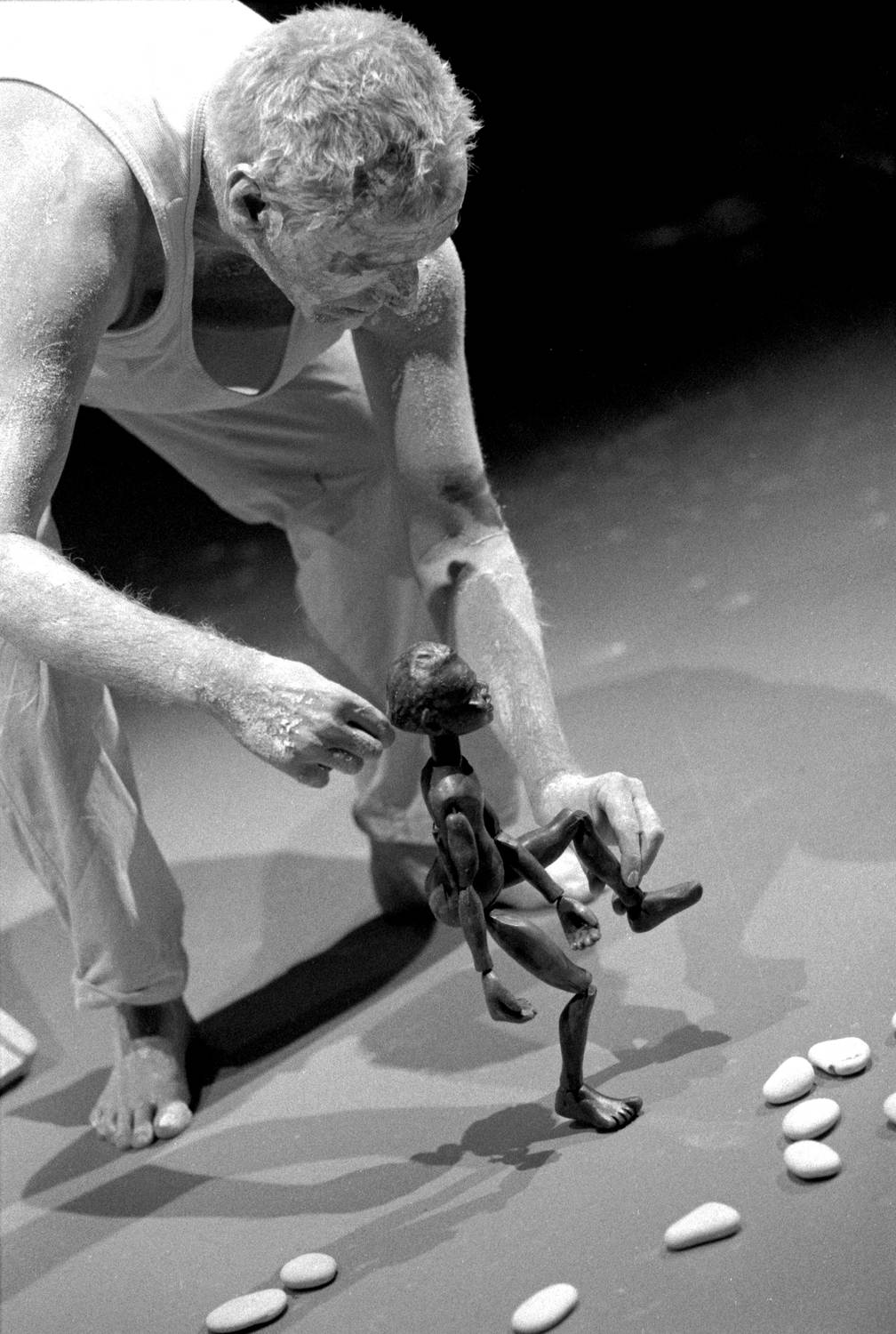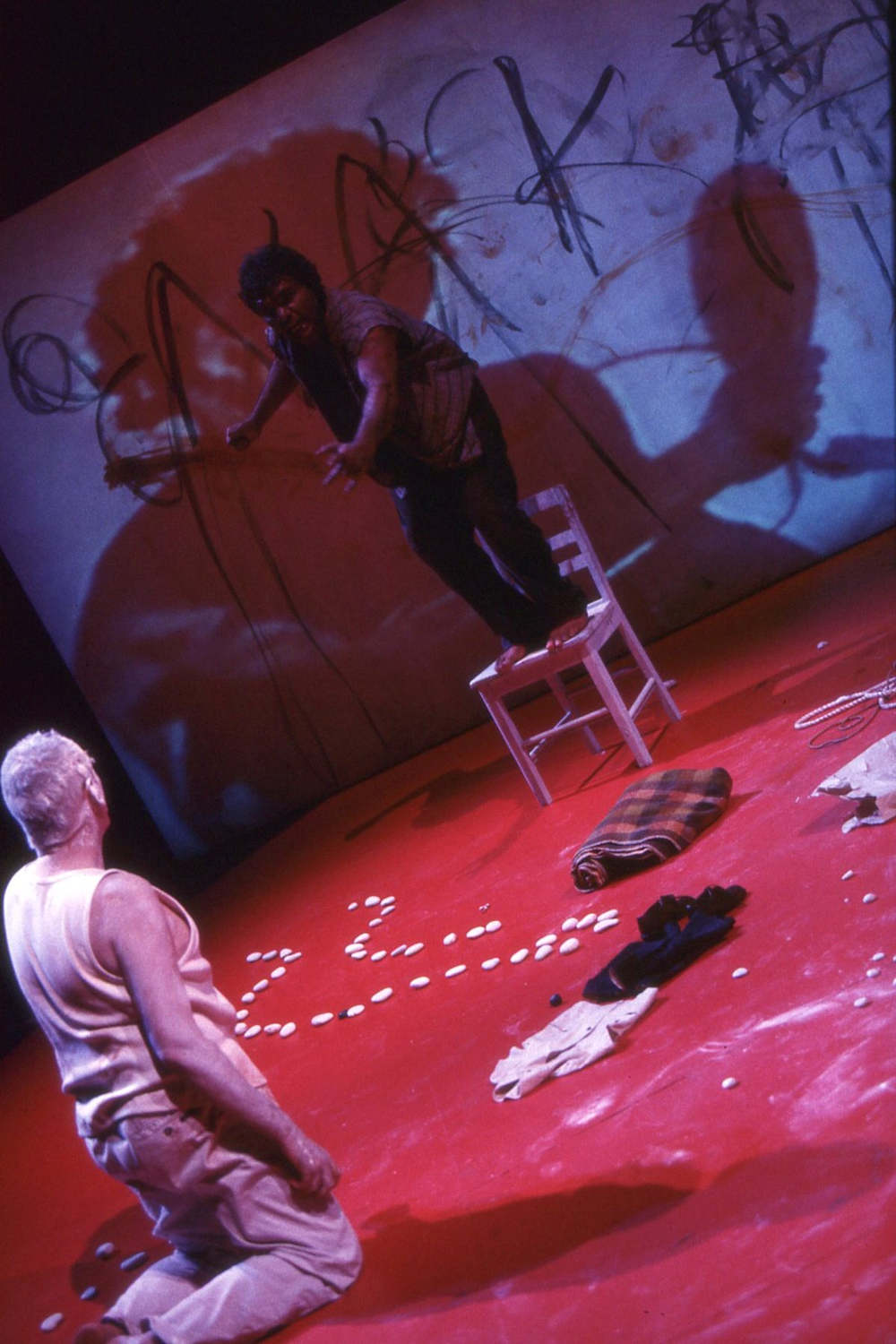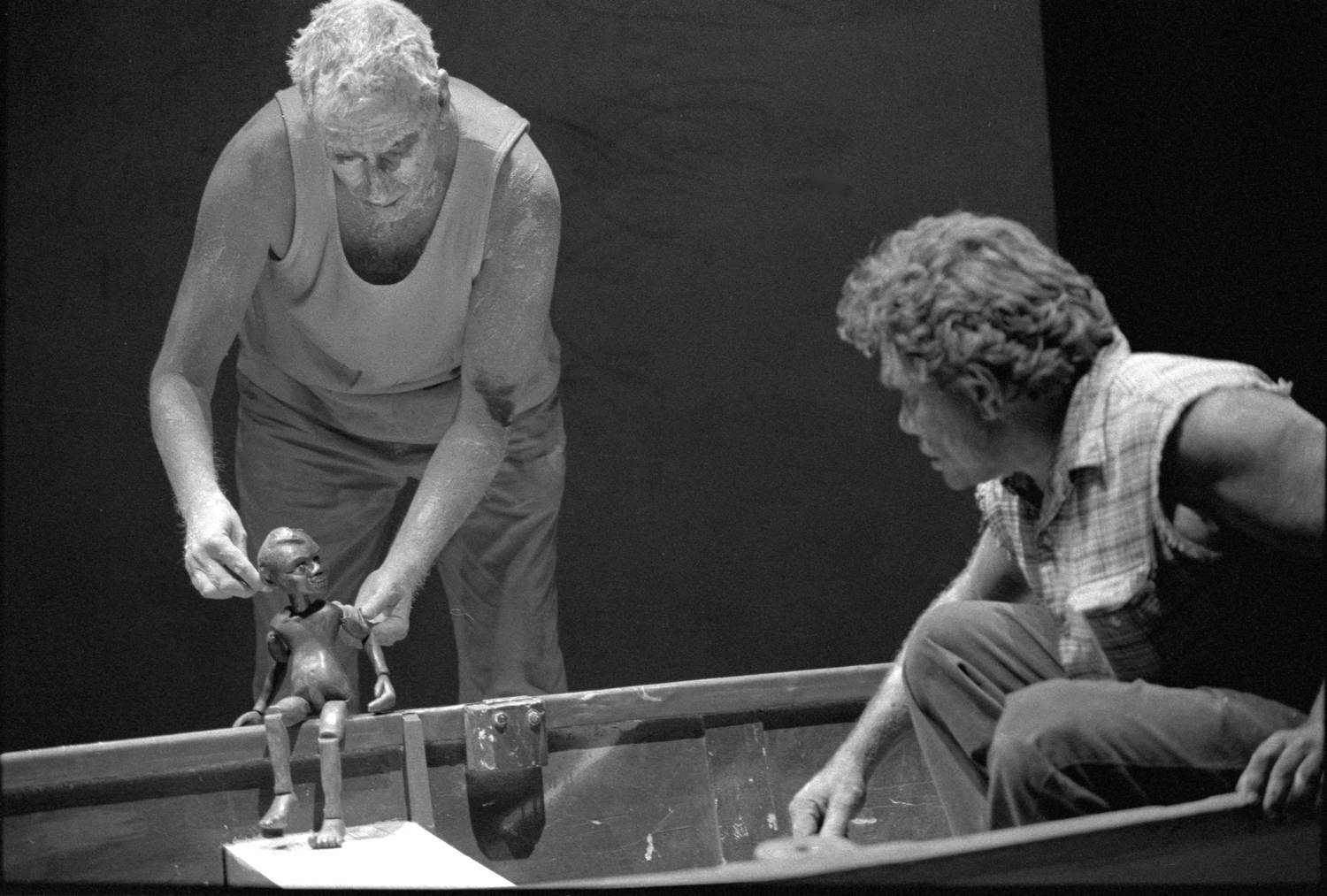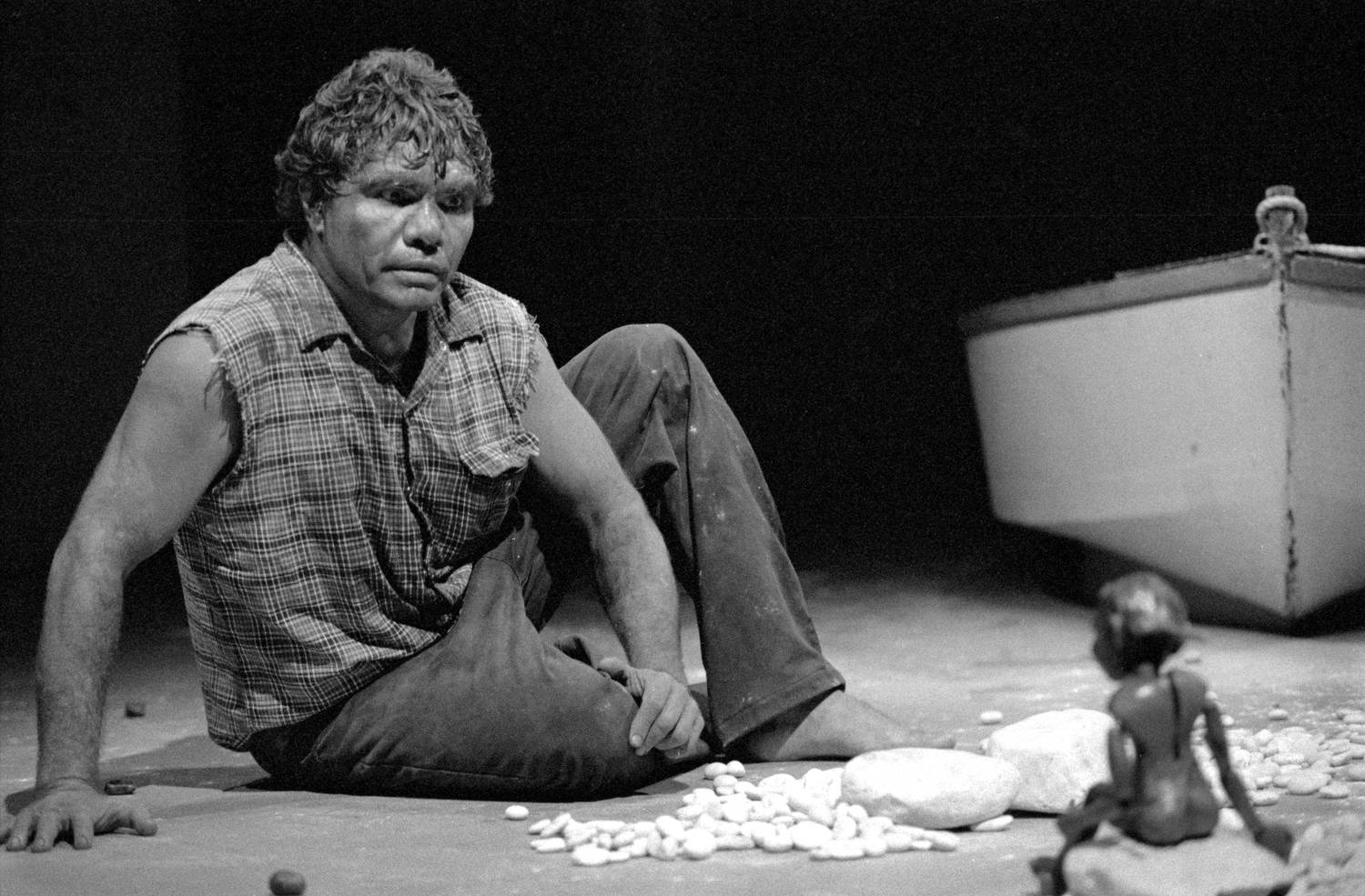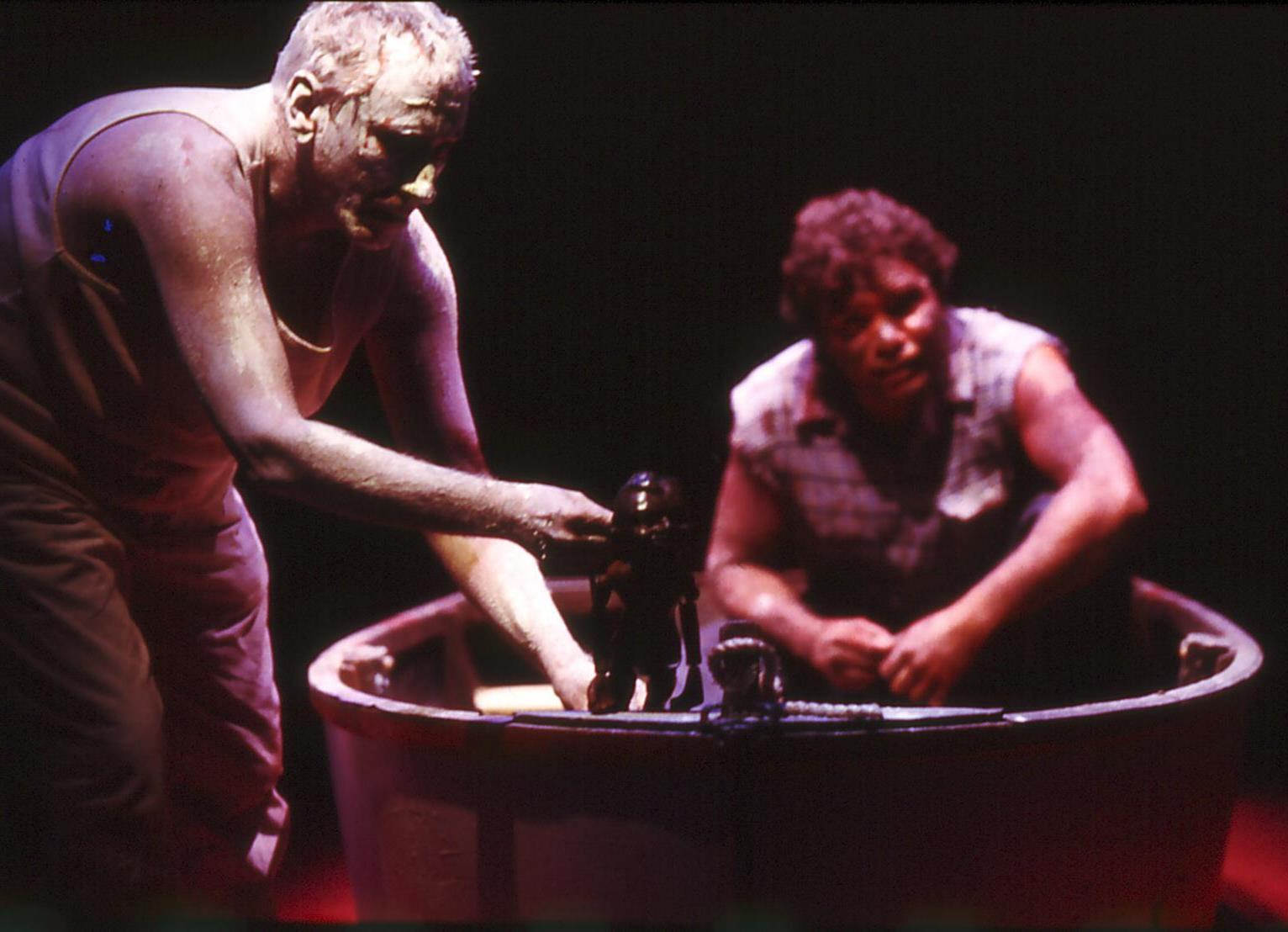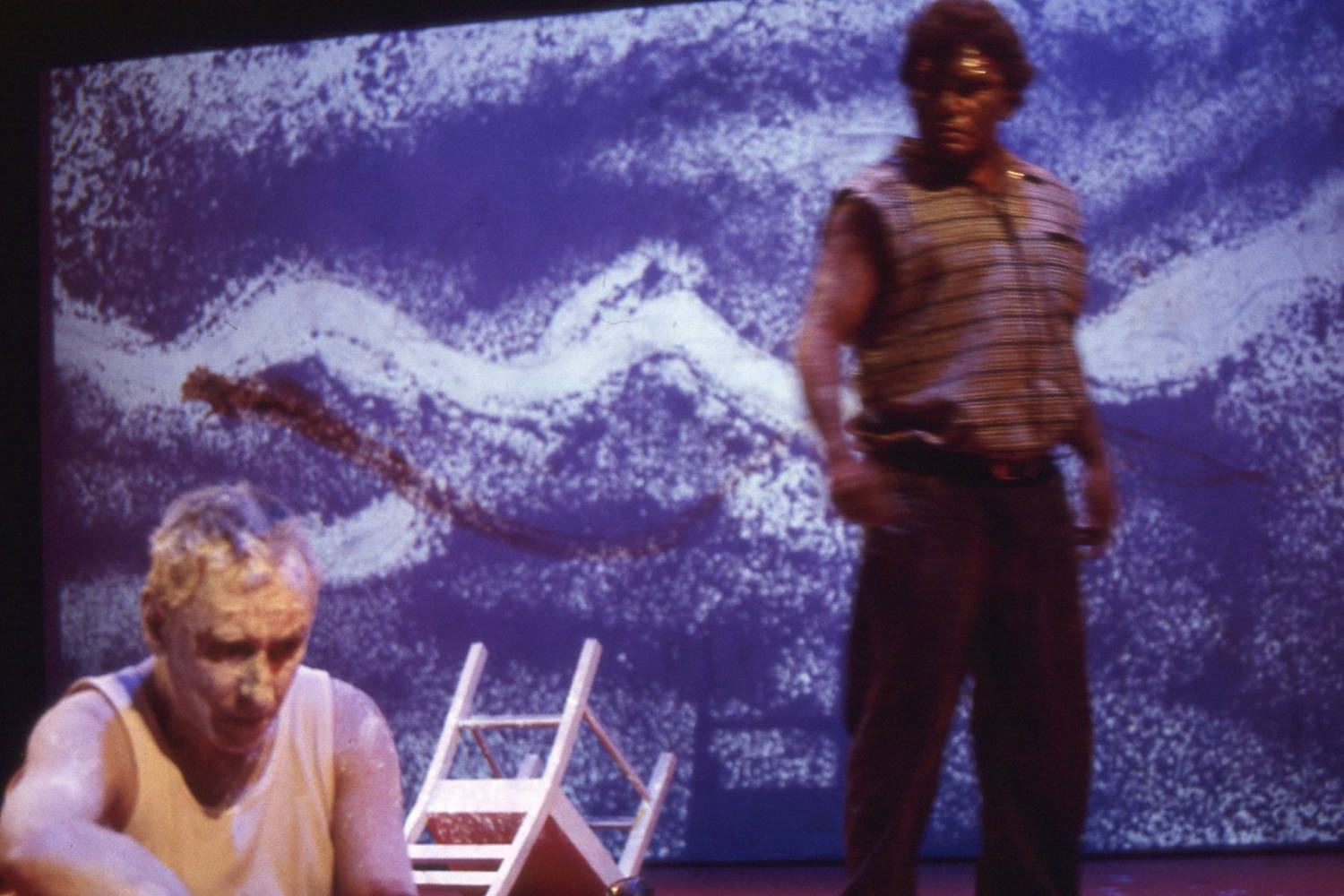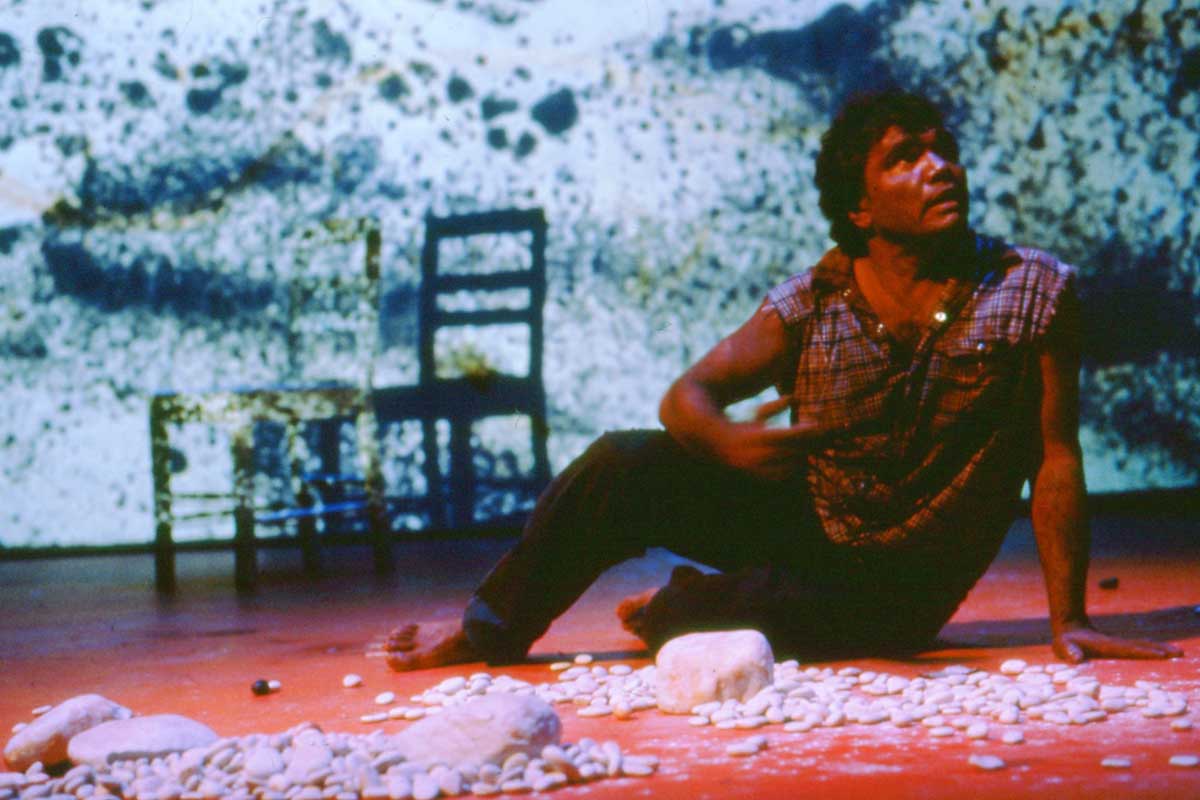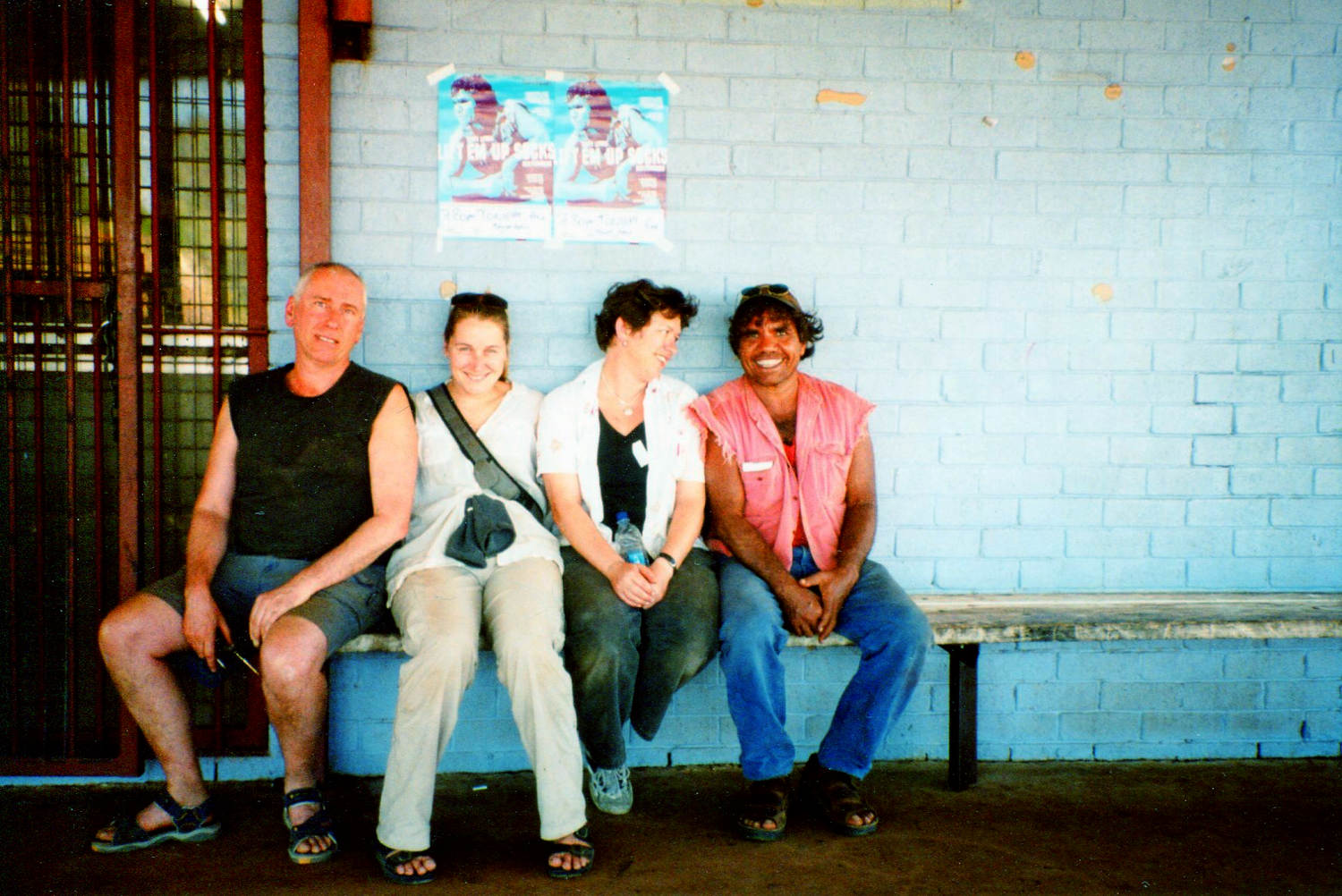| HANDSPAN VISUAL THEATRE | |
| Premiere | 5 April 2000 |
| Venue | George Fairfax Studio, Victorian Arts Centre |

LIFT ‘EM UP SOCKS, Handspan’s last production, was inspired by a collection of 1950s marionettes made by Australian puppeteer Bill Nicol which were lent to actor Tom E. Lewis for restoration. Most of the marionettes were European folk-tale characters but included were three Australian personalities made for the Jim Vickers Puppet Pantomime in 1958. One, a small Aboriginal boy, piqued Lewis’ curiosity and led him to approach Handspan and to the development of the play.
Directed by the company’s Artistic Director, David Bell and designed by Mary Sutherland with Puppetry direction by Heather Monk, LIFT ‘EM UP SOCKS was collaboratively created, and performed by Tom Lewis himself with puppeteer, Rod Primrose.
The play that emerged was a semi-autobiographical work, tracing Lewis’ life from growing up in Arnhem land to his sudden fame as a movie star, (The Chant of Jimmie Blacksmith, 1978); from the turbulence of alcohol abuse and estrangement from his family and community, to a new journey of self-discovery and reclamation of his life and traditions. Using the events in Lewis’ life as inspiration the work explored themes of personal, cultural and racial unity.
The production was an important work for Lewis, a high-profile indigenous artist and an Olympic torch bearer in Melbourne during the show's first season, he was keen to showcase the social malaise in many indigenous communities through the paradigm of his own life and to explain his culture, its stories and their relationship to his personal background.
I am an Aboriginal man and my richness comes through my culture that I love so much ... This for me is like a modern day corroboree, when I can put all my ideas and jigsaw it together
It is about the journey within ourselves and how we treat the rivers of our lives. I am not trying to preach to people. Sometimes you have to fall into your well and it gets darker and darker and it has to be up to you as a person to find a way to your light.
The Aboriginal boy string puppet replicated by Rod Primrose as a rod puppet for the play, signified Lewis’ spirit and memory of his childhood. The play's title recalls the instructions Lewis and his mission school mates received before the inspector's visit: lift 'em up socks, boys.
Lewis performed the work with Rod Primrose who, covered in white make up and wearing a white costume, represented the multiplicity of white people, generally figures of authority, in the stories of Tom’s life.
The 'lost boy' represented by the puppet figure must discover, as did Lewis, his geneology, and this cannot be found from books but from an oral tradition and from the land itself.
Rod and Tom manipulated the small Aboriginal boy puppet in turn. In Tom's hands, he re-enacted childhood memories. In Rod's, he provoked Tom to a protective nurturing or sometimes, to aggressive anger.
Primrose said of himself and the puppet that represents aspects of Lewis' personality and spirit that 'all three of us are the one character'
Lewis' rage is startling ...it comes with no warning and transforms this man into a terrifying force. We sense this is not just good acting, but past frustrations coming to the surface.
The work combined actors and puppets with video and projections. Drawings, writing and graffiti merged with water and rock formations to create a fusion of contemporary Aboriginal experience and Dreamtime storytelling. Videos included extracts from Tom E. Lewis' scenes in The Chant of Jimmy Blacksmith. Music composed by George Dreyfus for the film was included in the play's soundtrack.
Natural objects are strewn about the stage. Only when Tom bends down to pick up a pebble or use a pandanus leaf as a brolga wing, do we realise the set is a giant ‘map’ of his life. Ochre, clay, water, fire, feathers, wood. Stories, glass, light and a small marionette figure come to life as a ‘dot painting’ on stage.
Lift ‘Em Up Socks is quite an exceptional piece that resembles a painting as much as theatre. Its imaginative approach evokes thoughts and images that linger in the mind. A remarkable experience and recommended.
LIFT 'EM UP SOCKS was an innovative work that merged the company's puppetry-based performance style with 21st century digital imagery with effective and meaningful fluidity. It addressed contemporary issues, played across all age groups and was widely tourable. It was a new Australian work with flagship potential.
A fabulous production that is able to display the harshness of contemporary Aboriginal colonised experience with beauty and humour. The sophisticated racial dialogue, which develops between Primrose's silent white figure and Lewis' various fractured Aboriginal identities, speaks volumes for a possible reconciliation between Anglo and Aboriginal Australia... a 'must see' not only for its message but also for its brilliance of theatrical form and style.
The show, directed by David Bell, is deliberately impressionistic and its abstract visuals are important, linking words with images in suggestive, imaginative ways. Like much of Handspan’s work, it requires an active imagination on the part of the audience, for its narrative is not straightforward. In some ways it’s like learning to read a ‘dot’ painting, to understand a new symbolism that converts time, for example, into static visual symbols.
Stage management reports from Northern Territory performances in the heartland of Lewis' community, and at the Powerhouse in Brisbane note that the production universally received.
Great Audience Response - audiences were obviously captivated - some standing ovations.
LIFT ‘EM UP SOCKS premiered at the Arts Centre, Melbourne in 2000 and showcased later that year at the CINARS1
Canada showcase in Quebec. In 2001, the production toured the Northern Territory, played a return season in Melbourne and appeared at the Die Macht Des Staunens Festival in Vienna, Austria.
However, as director David Bell recalled, development and rehearsal of the work were fraught with ongoing personal troubles. Lewis' brother died and so did Bell’s father. There were floods in Arnhem Land which stranded Lewis miles from Melbourne during initial rehearsals.
These experiences of trying to keep afloat through adversity and finding a balance in life are the essence of the play.
No doubt the creation of LIFT ‘EM UP SOCKS was a complex and often disturbing venture for its creative team. Topically, the issue of white man’s destruction wrought on Australia’s indigenous peoples was, and is, one of conflicting opinion and attitude. Handspan had experienced mixed responses to THE HAUNTED, its 1988 cross-cultural work with an indigenous community, an equally complicated venture.
Critics of LIFT ‘EM UP SOCKS while universally intrigued, had reservations.
David Bell while conspired against by illness and flood seems no closer to pulling its competing elements into a coherent statement. More than that Bell seems wary of raising rage or vehemence in his production but concentrates on the damaged inner child that persecution and loss leave behind. It feels safe and old-fashioned when a gutsy through-line is need. …. What lingers in the mind is not all the theatrical intervention but the power of the individual voice. Lewis’s vocal range and presence are captivating enough but his utter absorption in the work is the best thing in this worthy but troubled show.
It’s very evocative and very elusive. It alludes to all sorts of things in a symbolic kind of way. Some I think is a bit obscure and it rambles a bit at times but generally, a good piece to watch.
This may be rather challenging for those with expectations of a clear-cut narrative sequence, a beginning a middle and an end. And there are some points where the show slows down and our attention falters distractingly.
By 2001 Handspan (by now renamed Handspan Visual Theatre) was floundering creatively and seeking a new Artistic Director. There was little energy for or interest in refining the work in the face of its inherent complexities and overwhelming production adversities. The play may have ushered in a new creative era for Handspan to lift 'em up socks and continue to operate under a new artistic leadership, but it was not the time2
Artists in other places were however, also merging genres and media in hybrid production styles - some perhaps influenced by Handspan's work - and visual theatre production for mainstage performance has since become a hallmark of much 21st century work across the globe. Increasingly too, indigenous artists are finding platforms and telling their own stories on the Australian stage.
Tom E. Lewis died in Katherine, Northern Territory in May 2018.
Footnote:
| Creative team | |
| Director | David Bell |
| Puppetry direction | Heather Monk |
| Designer | Mary Sutherland |
| Lighting designer | Nick Merrylees |
| Composer | Unknown |
| Costume designer | Unknown |
| Executive producer | Fleur Parry |
| Performers | Tom E. Lewis |
| Rod Primrose | |
| Production team | |
| Stage manager | Angela Pamic |
| Puppet maker | Rod Primrose (Aboriginal boy: replica Bill Nichol 1958 (By permission The Actors Agency, Melbourne)). |
| Set builders | Darryl Cordell, David Hope, Nicholas von der Borch |
| Tour tech/ASM | Murray Dempsey |
Rod Primrose with interested community members, Beswick bump-in, Northern Territory, 2001
| 2000 | |
| 5 April - | George Fairfax Theatre, Victorian Arts Centre, Melbourne VIC (6 performances) |
| 25 November - 1 December | CINARS Showcase, Moyse Hall, McGill University, Montreal, Quebec |
| 2001 | |
| 10 – 14 July | Powerhouse Theatre, Brisbane (1 preview & 6 performances) |
| 21 July - 26 July | Northern Territory Tour: Jabiru; Oenpelli/Gunbalayna; Manangrida;(3 performances & 1 workshop) |
| 28 & 29 July | Brown's Mart, Darwin Festival Fringe, Northern Territory (3 performances) |
| 2 - 3 August | Northern Territory Tour: Barunga Town Hall; Daly River (2 performances) |
| 2 – 7 November | David Williamson Theatre, Prahran, Victoria |
| 12 – 14 November | Dietheatre Kunstlerhaus, Die Macht Des Staunens Festival, Vienna, Austria (3 performances) |
| Total performances | 25 performances |
| Total audience | 310 (NT tour only) |
